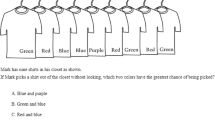Abstract
Based on a synthesis of research and observations of middle school students, a framework for assessing students’ thinking on two constructs—conditional probability and independence—was formulated, refined and validated. For both constructs, four levels of thinking which reflected a continuum from subjective to numerical reasoning were established.
The framework was validated from interview data with 15 students from Grades 4–8 who served as case studies. Student profiles revealed that levels of probabilistic thinking were stable across the two constructs and were consistent with levels of cognitive functioning postulated by some neo-Piagetians. The framework provides valuable benchmarks for instruction and assessment.
Similar content being viewed by others
References
Australian Education Council. (1994).Mathematics: A curriculum profile for Australian schools. Carlton, Victoria: Curriculum Corporation.
Biggs, J. B., & Collis, K. F. (1991). Multimodal learning and the quality of intelligent behavior. In H. A. H. Rowe (Ed.),Intelligence: Reconceptualisation and measurement (pp. 57–66). Hillsdale, NJ: Erlbaum.
Bogdan, R. C., & Biklen, S. K. (1992).Qualitative research for education: An introduction to theory and method. Boston: Allyn and Bacon.
Borovcnik, M. G., & Bentz, H. J. (1991). Empirical research in understanding probability. In R. Kapadia & M. Borovcnik (Eds.),Chance encounters: Probability in education (pp. 73–105). Dordrecht: Kluwer.
Brown, C. A., Carpenter, T. P., Kouba, V. L., Lindquist, M. M., Silver, E. A., & Swafford, J. O. (1988). Secondary school results for the fourth NAEP mathematics assessment: Discrete mathematics, data organization and interpretation, measurement, number and operations.Mathematics Teacher, 81, 241–248.
Case, R. (1985).Cognitive development. New York: Academic Press.
Dawson, C. J., & Rowell, J. A. (1995). First-year university physics: Who succeeds?Research in Science Education, 25, 89–100.
Falk, R. (1983). Children’s choice behaviour in probabilistic situations. In D. R. Grey, P. Holmes, V. Barnett & G. M. Constable (Eds.),Proceedings of the First International Conference on Teaching Statistics (pp. 714–716). Sheffield, UK: Teaching Statistics Trust.
Fennema, E., Carpenter, T. P., & Peterson, P. (1989). Teachers’ decision making and cognitively guided instruction: A new paradigm for curriculum development. In N. F. Ellerton & M. A. Clements (Eds.),School mathematics: The challenge to change (pp. 174–187). Geelong, VIC: Deakin University.
Fischbein, E., & Gazit, A. (1984). Does the teaching of probability improve probabilistic intuitions?Educational Studies in Mathematics, 15, 1–24.
Fischbein, E., Nello, M. S., & Marino, M. S. (1991). Factors affecting probabilistic judgments in children and adolescents.Educational Studies in Mathematics, 22, 523–549.
Fischer, K. (1980). A theory of cognitive development: The control and construction of hierarchies of skills.Psychological Review, 57, 477–531.
Green, D. R. (1983). A survey of probability concepts in 3000 pupils aged 11–16. In D. R. Grey, P. Holmes, V. Barnett & G. M. Constable (Eds.),Proceedings of the First International Conference on Teaching Statistics (pp. 784–801). Sheffield, UK: Teaching Statistics Trust.
Hawkins, A., & Kapadia, R. (1984). Children’s conceptions of probability: A psychological and pedagogical review.Educational Studies in Mathematics, 15, 349–377.
Hogg, R. V., & Tanis, E. A. (1993).Probability and statistical inference (4th ed.). New York: Macmillan.
Jones, G. A., Langrall, C. W., Thornton, C. A., & Mogul, A. T. (1997). A framework for assessing and nurturing young children’s thinking in probability.Educational Studies in Mathematics, 32(2), 101–125.
Jones, G. A., Thornton, C. A., & Putt, I. J. (1994). A model for nurturing and assessing multidigit number sense among first grade children.Educational Studies in Mathematics, 27, 117–143.
Kahneman, D., & Tversky, A. (1972). Subject probability: A judgment of representativeness.Cognitive Psychology, 3, 430–454.
Konoid, C., Pollatsek, A., Well, A., Lohmeier, J., & Lipson, A. (1993). Inconsistencies in students’ reasoning about probability.Journal for Research in Mathematics Education, 24, 392–414.
Larsen, R. J., & Marx, M. L. (1986).An introduction to mathematical statistics and its applications (2nd ed.). Englewood Cliffs, NJ: Prentice-Hall.
Miles, M. B., & Huberman, A. M. (1984).Qualitative data analysis: A sourcebookfor new methods. Beverly Hills, CA: Sage Publications.
Mounoud, P. (1986). Similarities between developmental sequences at different age periods. In I. Levin (Ed.),Stage and structure (pp. 40–58). Norwood, NJ: Ablex.
National Council of Teachers of Mathematics. (1989).Curriculum and evaluation standards for school mathematics. Reston, VA: Author.
Piaget, J., & Inhelder, B. (1975).The origin of the idea of chance in children (L. Leake, Jr., P. Burrell, & H. D. Fischbein, Trans.). New York: W. W. Norton.
Romberg, T. A., & Carpenter, T. P. (1986). Research on teaching and learning mathematics: Two disciplines of scientific inquiry. In M. C. Wittrock (Ed.),Handbook of research on teaching (3rd ed., pp. 850–873). New York: Macmillan.
Shaughnessy, J. M. (1992). Research in probability and statistics: Reflections and directions. In D. A. Grouws (Ed.),Handbook of research on mathematics teaching and learning (pp. 465–494). New York: Macmillan.
Shulman, L. S. (1986). Those who understand: Knowledge growth in teaching.Educational Researcher, 15(2), 4–14.
Watson, J. (1995). Conditional probability: Its place in the mathematics curriculum.Mathematics Teacher, 88, 12–17.
Zawojewski, J. S. (1991).Curriculum and evaluation standards for school mathematics, Addenda series, Grades 5–8: Dealing with data and chance. Reston, VA: Author.
Author information
Authors and Affiliations
Additional information
An erratum to this article is available at http://dx.doi.org/10.1007/BF03217316.
Rights and permissions
About this article
Cite this article
Tarr, J.E., Jones, G.A. A framework for assessing middle school students’ thinking in conditional probability and independence. Math Ed Res J 9, 39–59 (1997). https://doi.org/10.1007/BF03217301
Issue Date:
DOI: https://doi.org/10.1007/BF03217301



